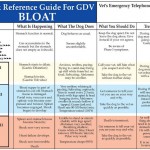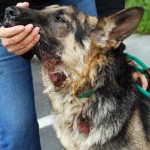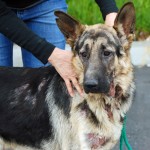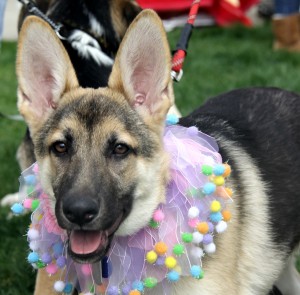Health (9)
Bloat Chart
Be familiar with the symptoms of bloat or gastric torsion. Knowing the symptoms can help save your dog’s life, it is a true emergence situation. View the chart here.

Hypothyroidism in Dogs
Is your dog lethargic and losing its hair coat? It may not be old age — it may be treatable hypothyroidism.
Hypothyroidism is the most common endocrinopathy (glandular disorder) in dogs. The thyroid gland, due to inflammation or atrophy of un-known origins, becomes incapable of producing an adequate amount of thyroid hormone, and dogs develop clinical signs of hypothyroidism. The signs are quite variable, because thyroid hormones are needed for normal metabolism, and deficiency can affect nearly all body systems, including the skin, the reproductive tract, the neuromuscular system and the cardiovascular system. Metabolic signs include lethargy, sensitivity to cold, mental dullness, unwillingness to exercise and a tendency to gain weight despite eating less food than normal. Because some of these signs progress fairly slowly, dog owners may unconsciously adapt to the changes in their pets and fail to recognize them as problems.
The most common abnormalities seen in hypothyroid dogs involve the skin and haircoat. A dry, dull, flaky coat is most often described, with hair that is easily pulled out. Hair loss often occurs in a characteristically symmetrical pattern on both sides of the body, sparing the head and legs; some dogs develop a “puppy coat,” as the guard hairs fall out preferentially, leaving the soft undercoat behind. Sometimes the hair loss only involves the tail, giving affected dogs a “rat tail.” Although skin and hair problems are more unsightly than health-threatening, signs that relate to vital organ systems, if undiagnosed and untreated, have the potential for serious illness.
Lick Granuloma – Is that a Hot Spot?
What you think you think is a hot spot may be a lick granuloma. Find out more about this condition here.
Sudden Onset Limping in Your Young German Shepherd?
Is your dog a large breed dog, 18 months or younger, with sudden onset very painful limping? Don’t think hip dysplasia, think Panosteitis (or “growing pains”). This condition is sometimes even misdiagnosed as vets. Because it is so very common in German Shepherds, particularly males, you should become familiar with the symptoms. While not life threatening and self-limiting, you should still see a vet to confirm the diagnosis, and many dogs get relief with short term pain management. Learn more.
Need a Vet?
Below are some suggestions for veterinarians our supporters recommend. Let us know what you think, and if you have more recommendations!
Dentistry:
Pacific Coast Veterinary Dentistry and Oral Surgery
For many years we’ve only had one choice for specialty veterinary dentistry in San Diego. Now we have another choice, one who gets great reviews from SCGSR supporters.
Use of Ponazuril for Coccidia
The best way we’ve found to treat coccidia in incoming animals is by using ponazuril off-label (Marquis paste for horses). One treatment and then another 10 days later is all it usually takes, and its cost-effective in shelter environments. Here’s a link to how to use it.
Demodex, Scarcoptic Mange & Allergies
TREATMENT OF DEMODEX OR DEMODECTIC MANGE
Since all dogs carry demodectic mites, we believe dogs who have problems are sufferinng from a compromised immune system. We do everything possible to build up their immune system, and let the dog’s body do the work of fighting off the mites. Avoid ALL poisonous dips and do not put ANYTHING toxic on your dog’s skin. Never resort to Mitaban for demodectic mange. Mitaban can be used with discretion for sarcoptic mange, but Revolution is the best treatment for sarcoptic mange and less toxic to your pet. Revolution has no effect on demodectic mange. If your dog is suffering from a skin infection secondary to the mites, she/he will need to be on antibiotics. Here’s what we do:
Bathing: You will need to bathe your dog every day to three times a week depending on the severity of the demodex/infection. Use a high quality shampoo such as Masaleb (www.omahavaccine.com or www.vetamerica.com) and let the shampoo sit on the dog’s coat for 10 minutes before rinsing. This will clear debris from the pores and help reduce the number of mites. As the condition of the dog improves, you can gradually bathe less and less, until the condition clears completely. Make very sure to have clean bedding (you can use old sheets to cover their beds).
Diet: It is extremely important that your dog be on a high quality diet which doesn’t include any wheat, corn or eggs. All are highly allergenic and can set up conditions perfect for mites. The dog’s diet shouldn’t contain any toxic preservatives, “animal digest” (which is all different parts of animals not used for people food – use your imagination) and the first ingredient should be high quality protien such as chicken or duck. Always check ingredients for toxic preservatives. If you don’t know what something is, look it up on the internet. Okay starches would be potato, barley or rice in that order. We have the best luck with Innova Evo, which is a dry dog food with no grain, just animal protien, plant and fruit, very close to a dog’s natural diet. Many people with demodex dogs choose to feed a raw diet which takes a bit of learning but is very helpful to these dogs. See information about feeding your dog in our FAQ section. Face it, you love your pet. You can’t feed it for a dollar a day and expect it to have a healthy and long life. For $2 a day you can have a longer living and healthier pet. Your choice. Don’t wait until your dog starts to experience health problems before you start thinking about its diet.
Supplements: Your dog should be supplemented with human grade zinc, ester C, and multiple B vitamins (just like you would buy for yourself) once a day. Also very important is supplementing your dog with Omega oils such as flax or salmon oil. We buy it in big sqeeze bottles at health food stores such as Henrys.
Exercise and Well Being: Your dog should be living in a clean environment. Dogs are pack animals and should be allowed to sleep in the house with their owners, otherwise you will have a stressed and anxious dog. You should be sure to play with your dog and take it for walks for, at the very least, a half an hour to an hour a day. Many dogs, especially young strong breeds, are built to hunt or herd for hours a day to earn their food and they only rest when they’ve done their job or achieved their goal. Us city dwellers must make up the difference for our pets. A tired dog is a happy and stress free dog. And as a bonus, most likely this happy dog will be living with a happier and healthier human family.
Ivermectin: As a last resort in dogs who can’t improve on their own, we give ORAL ivermectin. NO dips. This is injectible Ivomec (ivermectin) 1%cc, which we draw into a syringe, take the needle off of the syringe and put the evermec down the back of the dog’s throat (it tastes terrible!). A 70 pound dog should get 1cc once a day. This is less than vets recommends, but it works because its part of immunity building plan.
Skin Infection: If your dog has a skin infection secondary to demodex (called pyoderma), you will need to put it on a course of antibiotics. Depending on the dog’s condition you can begin with an antibiotic recommended by your vet. If your dog doesn’t respond, you can switch to a broader spectrum antibiotic, or if you can afford to have a culture done, that’s the best way to determine treatment. The culture will tell you which antibiotics will work best for your dog, and they should begin recovering right away. As the stress of the infection clears, her body is also getting better control of the mites.
Be aware that while most dogs will overcome demodex, some pets will need you to be alert to all these things over their entire lifetime. Most dogs will develop and immune system, with your help, that will beat the mites completely. Some dogs will need continuing care and strict attention from their owners to keep the condition in check.
If you’ve discovered a great way of dealing with demodex, we’d love to hear from you! And because skin conditions are of particular interest to us, please feel free to email us with any questions or comments about your experience with demodex. Email marcy@socalrescue.org.
Titan was turned in to SCGSR at nine months of age in January 2012. He had a deep, smelly skin infection from neglected demodex, so deep that he was bleeding through the t-shirt his owner brought him to us wearing. He had a ripped ear from being kenneled outside with two wolf hybrids, and a severe tapeworm infestation. Two weeks later he has beat his skin infection, been wormed, vaccinated, neutered, microchipped and had the rip in his ear repaired thanks to SCGSR supporters. Titan was treated with weekly hour-long 3 suds-up soaking baths, wormed with Drontil Plus, cephalexin anitibiotics, 1000 mgs two times a day, and was fed raw chicken only for the first week, along with fish oil caps as a supplement. That’s it.
Food
What have we learned over 11 years of rescue and about 800 dogs? German Shepherds are very sensitive to food! Certain ingredients almost always cause problems. You can save money on food but then spend it at the vet dealing with hot spots, fur loss, gastrointestinal issues and scratching, or you can educate yourself and spend a little more on food and avoid all these issues, for the most part.
First and foremost, read the ingredient labels and know what to look for. Spending a lot of money for food doesn’t necessarily mean your German Shepherd will thrive on it. Dog food has swung over the past 10 years from quality food being hard to find to an amazing array of premium foods, many formulated and advertised to appeal to your human tastes and ideas of nutrition.
Keep it Simple!
Many high price foods contain so many ingredients, you can be sure your German Shepherd will find something to be allergic to or which he can’t digest, which will result in problems nobody wants to deal with.
Single protien, single starch foods are what we find works best. If your dog is eating food with multiple proteins or starches, you will have a much more difficult time figuring out what’s bothering him. If you stay with single protien/single startch, you can easily switch from turkey to salmon, rice to sweet potato, or vice-versa. We have the best luck with limited ingredient diets, and we recommend Dick Van Patten’s Natural Balance Limited Ingredient, and Nature’s Domain which is also sold at Costco and is very reasonably priced. Our rescued dogs and puppies thrive on Nature’s Domain.
Ingredients to Avoid.
Dogs suffer from food intolerance far more than from allergies to their environment. Here is a list of the most common allergens. If your dog has allergies and you have him on a limited ingredient diet, you can switch diets and see if there is improvement, avoiding these ingredients. Always switch diets slowly by mixing prior food with new food in increasing proportions to avoid upset stomachs! Remember treats and snacks of any kind may introduce allergens, and avoid their use during your experimentation with diet. Pig ears, rawhide, and any food/treat that says “wash your hands after touching” should not be introduced to your dog’s diet – ever. If you wonder why, google how they’re made.
Raw Feeding.
Do we? Yes we do, at times. When we rescue very debilitated dogs and puppies, we have seen raw diets bring them back from death’s door. Do we feed bones? Only ground bones since we’ve been to the vet more than once to have a bone fragment removed from the exit point. Once a dog has gotten back on its feet, we switch it back to a quality limited ingredient diet. Raw feeding is a commitment on your part, with a lot of learning and time involved, and it can be very worthwhile depending on your dog’s particular issues.
Supplements.
Every dog will benefit from fish oil capsules and they learn to love them. Northern breeds such as Huskies often suffer from zinc deficiency and will suffer from thinning patches of fur and begin to recover immediately once zinc supplementation is initiated. Read about zinc deficiency. If you’re feeding your dog a healthy diet on which he’s doing well and is healthy, other supplementation is usually not required until a dog enters his senior years, when supplementation to help with joints can begin.
Information (2)
Finding the Right Dog for Your Family
Frequently Asked Questions: On Choosing the Right Dog for Your Family
How do I get started choosing which dog I want to adopt?
The first thing to do is visit our website, and click to see the “Available Dogs.” We do our best to keep this list current, and you’ll find pictures and short descriptions of each amazing dog we have available for adoption. It’s normal to be attracted to a dog based on his or her appearance-but we encourage you to carefully read their bios, to find a dog whose temperament and energy level match your lifestyle. Housebreaking and socializing young puppies is lots of work! Some of our dogs will make ideal condo-dogs, while others need more focused work and activities. Some dogs are good with cats, kids, strangers, and other dogs. Some are not. We do our best to get to know our dogs, through fostering and training, so we may recommend specific dogs to you based on your application.
Submitting an online application is the next step in the process. Be sure to indicate which dogs you’re especially interested in, and what qualities are most important to you in your future family member. Are you looking for an active dog, to run or hike with? Does your dog need to be good with cats? small dogs? children? Are you looking for a mellow, hang-around-the-house dog? (There are SOME German Shepherds who are couch potatoes!) Do you want a dog that’s already housebroken, or that has some obedience training? Do you want to play dog sports, like agility or flyball? Do tracking, search-and-rescue, or obedience? All of these factors can help us determine which dogs will fit in to your lifestyle. Once you’ve submitted your application, an adoption counselor will be in touch, and will help arrange meetings with potential dogs. Also, please join us at our adoption events! It’s a great way to meet lots of our adoptable dogs, and see whose temperament is a good fit for you.
What does SCGSR know about the personality of the dogs?
Many of our dogs live in foster homes with volunteers, who are able to observe them and interact with them on a daily basis. What the volunteers learn about the dogs-house habits, responses to children, small animals, other dogs, obedience commands, energy level, favorite toys, etc-we include in the dog’s description on our website. Foster homes also help socialize the dogs, teach them basic commands, and consider what kind of homes will be the best fit for their dogs. Although we often don’t know much about the dog’s history, through fostering and interacting with each dog, we can gain a good sense of their current personality. It’s impossible to guarantee a dog’s response in every imaginable situation, but we do our best to get a general sense of who each dog is, and how they are likely to behave.
How can I tell if a dog will get along with my children? Also, what are some tips to keep my child safe around dogs?
This is a great question! It’s up to us to make sure that interactions between dogs and children are safe and positive.
It’s important for us to teach our children safe and respectful ways to interact with all dogs, especially unfamiliar dogs. Children should never approach a dog that they aren’t familiar with, and they should always ask permission before reaching out to pet a dog. Dogs can be possessive over food and treats, so a child should never try to pet an unfamiliar dog when it’s eating or chewing a bone. And we all know that it’s never ok to hit or kick a dog, or pull on its ears or tail-so we have to be sure our kids know that too!
What are some good things for kids to do around dogs? First, they should ask the owner before approaching the dog. Reach out a hand or fist for the dog to sniff before petting it. Pet dogs softly, avoiding sensitive areas like the eyes or ears. Look at the dog’s chest or back instead of staring directly into its eyes. If a dog runs up to you, pretend you’re a tree-hold still and look at the ground, instead of making noises or running. These suggestions are all good for adults, too!
In regards to SCGSR available dogs, we do our best to get to know the dogs, and to test their interactions with children. Many German Shepherds are fantastic with kids! The dog’s history, past experiences with children, and personality all help determine how good a dog is with children. Of course, German Shepherds are large dogs, so they can accidentally knock down small children when they’re excited, and some individuals with a high herding instinct will nip at the heels of running kids-adults too-as if they’re sheep. Many of these behaviors can be eliminated with training-of both the dog and child! Depending on the age of your children, SCGSR volunteers will help match you with a dog that can live happily with your family.
At adoption events, please keep your children with you, and ask the dog’s handler before approaching or petting a dog.
How can I tell if a dog will get along with my other pets?
While there are some German Shepherds who are great with cats, hamsters, guinea pigs, and other small and furry creatures, the reality of our breed is that they often are NOT good with these types of pets! We do our best to “cat test” adoptable dogs; if an adult dog comes to us from a home where it was raised with cats, or if it is fostered in a home with cats, we try to note that in their bios. Also, most young puppies will be good with cats if they’re raised alongside them. For adult dogs that come to us without a family history, or for dogs with a strong prey drive, we assume they will not live calmly with a cat, and note that in their bios. Even if the dog you adopt has lived with cats in the past, there are some good guidelines to follow as you introduce the new family member. Make sure that your cat has a safe place to go-either up high, or into a room that the dog can’t enter. Never leave your cat unattended with your newly adopted dog until they’ve been supervised together for several weeks. Patience and determination can help you teach some dogs to ignore or accept cats, and there are many resources available to help you. If you are adopting a second or third dog, we will arrange a meeting on neutral ground for the dog you’re interested in, and your current dogs. Please do NOT bring your current dogs to adoption events-it’s difficult to have a calm, successful meeting around so many strange dogs. It will take time for your new dog to acclimate to his new pack, and it’s perfectly normal for dogs to have a few loud, brief squabbles, as they adjust their social dynamics. Patience and supervised, structured activities, such as long walks as a pack, will help your new family member settle in.
Are all the dogs spayed or neutered?
Yes, all of our adoptable dogs have been spayed or neutered. The only exception is our young puppies, and they will either be “fixed” before they go to their new home, or by a specific age, which will be part of their adoption contract. One of SCGSR’s main expenses is altering adult dogs we save from shelters-and there wouldn’t be so many unwanted dogs in need of rescue if people would be more responsible about spaying and neutering! There are many low-cost options, such as the Neuter Scooter, and too many dogs die in shelters daily for there to be any excuse. If you are not showing your dogs in breed competitions, working to improve the breed, then your dog should be sterilized. ANY mixed-breed dog should be sterilized as well. Pet overpopulation is a problem that we can solve. A last word before we get off this soapbox: sterilizing your dogs increases their long-term health and longevity, makes male dogs less territorial and aggressive, prevents females from attracting unwanted attention at dog parks, and leads to a calmer, more balanced pet.
Are all the dogs up to date on shots?
Yes, all of our adoptable dogs are current on rabies and DHLPP, except for our young puppies, who may require booster shots after going to their new homes. Dogs require annual vaccination boosters, so after adopting any dog, please talk to your veterinarian about getting them on a vaccination schedule. Prevent disease, and prevent the heartache and financial burden of a sick pet!
What does SCGSR know about the health history of these rescued dogs?
If the dog was turned in to rescue by an owner, sometimes we have their medical records, which we will pass along to their adoptive family. Dogs that come to us from animal shelters often don’t have any medical history. SCGSR treats any medical condition that our dogs arrive with-often to the cost of thousands of dollars, in the instances of puppy parvo, adult pneumonia, or skin problems. Vet expenses are SCGSR’s number one expense, and each dog often costs much more to save than the adoption donation. We do our best to give each dog a chance to start over healthy and happy! Once the dog is adopted, its care becomes the responsiblity of the new owner.
Does SCGSR know if the dogs have hip dysplasia?
If a dog with a previous diagnosis of hip dysplasia is turned in to the rescue, we will pass that information along to its adopter. Barring a medical history, x-rays are the only reliable way to diagnose dysplasia, and SCGSR can’t afford to x-ray every dog.
If you adopt one of our dogs, you are welcome to have it x-rayed by your vet, at your expense. We can also arrange for x-rays to be done by our vet at a reduced price. If you’re concerned by the results, we’re happy to take the dog back into rescue. Although in the past, hip dysplasia was incredibly common in German Shepherds, responsible breeding has lessened its occurrence-although all large breed dogs can face this condition.
Depending on its severity, treatments options range from hip surgery ($1000-$3000 per hip) to non-surgical options like joint supplements of glucosamine and chondroitin. If you face this condition with a future dog, your vet can help determine what treatments are right for your dog. We highly recommend insuring your dog, so that you can provide the medical care necessary to improve its health and quality of life.
What can I do if the dog has a behavior problem?
First off, no dog is perfect! At some point in your dog’s life, you’ll want to change some aspect of their behavior. Whether it’s keeping them off the counters, or improving their behavior on a leash, it’s up to us to teach our dogs how we want them to act. Almost all behavior “problems” can be solved, given the tools, resources, and love and patience required.
If you feel your dog’s behavior is a danger to himself or others, take immediate steps to make everyone safe in the short-term, while you work on a long-term solution. Dog is breaking out of your yard when you’re away? Buy a crate, and crate your dog when you’re gone-for a reasonable amount of time, of course! Dog is terrorizing your cat? Never leave them unattended-confine your cat to a specific area of the house that your dog can’t access.
For a longer-term solution, arm yourself with knowledge. Dog behavior and dog training books abound! See if you can find resources for your specific problem. Try to think about your dog’s perspective, and why he’s engaging in this unwanted behavior. Remember that we often inadvertently create the behavior we don’t like; if we pet our dog when she jumps on us, she’ll think that all people love to be jumped on!
Don’t hesitate to consult a professional trainer as well! We’re happy to recommend trainers we’ve worked with, and often your vet or local dog wash has a trainer to recommend.
Start working to change the unwanted behavior right away, but remember that changing a behavior or habit takes time. Consistency and patience, and reasonable expectations for progress, will help both you AND your dog. And remember, no dog is going to be perfect all the time: we can teach them all we want, but we have to love them even when they make mistakes.
Before you adopt a dog, please consider how much time, energy and resources you’re willing to invest in helping make your dog a good citizen. These dogs have already had someone give up on them at least once, often for no fault of their own, and they deserve a home that is willing to work hard to give them a good life.
Why would I want to do obedience training with my dog?
Because it’s fun! Any type of training or structured activity, like obedience or agility, helps you bond with your dog, develop a relationship of trust and respect, and makes your dog a better companion. There are many resources and training methods out there; we encourage you to seek out professionals who use “positive training” techniques. German Shepherds love to learn, and they love being rewarded for their work! Often, minor behavior problems disappear when a German Shepherd begins an obedience course; the mental stimulation and positive time with the owner works wonders on dogs as smart as these. “Puppy Kindergarten” classes are great tools for socialization for young dogs, and regular obedience courses help dogs learn to focus on you and your commands even when there are lots of distractions around. You can even do obedience training at home, and involve the whole family! We love The Idiot’s Guide to Positive Dog Training!
Thank you for visiting us, and for being part of our rescue community!
About the Breed – a Must Read
Find a must-read wikipedia article for any current or future owner of a German Shepherd Dog here.











